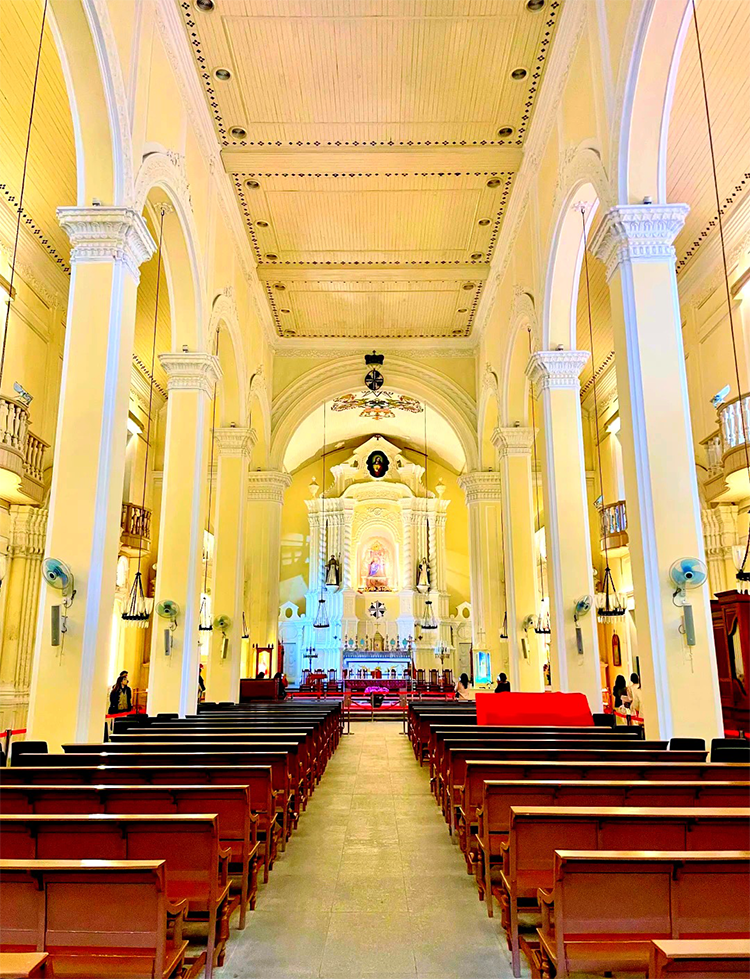St. Dominic’s Church Macau: 400 Years of Baroque Splendor – Visitor’s Guide & Highlights
1. Introduction: A Bright Yellow Poem of Faith
Turn a corner in Macau’s historic center and you may suddenly meet a burst of bright ochre — St. Dominic’s Church (Igreja de São Domingos) stands like a South European noble transplanted into the East, singing four centuries of faith. Sunlight dances across Baroque scrollwork, while white window frames trace colonial silhouettes. This UNESCO World Heritage site is not only one of Macau’s oldest churches but also a living museum of religious art.
2. Soul Decoded: A Landmark of East–West Faith
Called “one of the most intact Baroque Catholic churches in Asia,” St. Dominic’s Church is a vivid testament to the maritime Silk Road. Built in 1587 by Dominican friars using timber shipped from the Philippines, the church combines a unique “three-bar” composition — Baroque architecture, a basilica plan, and Batavian-style decoration — reflecting Portuguese influence in the Far East. As a religious hub for the Portuguese community, it hosted early Western music education in Macau and preserves a copy of the 1576 papal decree that established the Macau diocese.

3. Corridor of Time: From Wooden Chapel to World Heritage
Originally a wooden chapel in 1587, the church was rebuilt in stone after 1600. Reconstructed again after the great 1835 fire, its current appearance merges European Baroque with Lingnan craftsmanship — look under the eaves for ceramic gargoyles that combine Chinese apotropaic motifs with Western form. When the site was inscribed on the World Heritage List in 2005, experts highlighted its significance as a milestone in the spread of Catholicism across East Asia. Inside, 17th-century oil paintings, including the portrait of St. Francis Xavier, recall Macau’s heyday as a gateway to the Orient.
4. Architectural Code: A Flowing Baroque Feast
4.1 Exterior: A Concerto of Light and Color
The bright yellow façade with crisp white trim follows a Portuguese colonial palette that glows under Macau’s subtropical sun. The three-tiered façade represents heaven, earth and hell in traditional Christian symbolism, and the triangular pediment still bears the clear emblem of the Dominican Order.
4.2 Interior: A Golden-Proportioned Theater of Faith
Step inside and the 24-meter-long nave strikes you immediately. Corinthian columns direct the eye toward the altar, while tall clerestory windows let shafts of light fall like the Holy Spirit over blue Portuguese-style tiled floors. Notable features include:
– High altar: A gilded Virgin of the Rosary surrounded by twelve silver stars, evoking the Apocalyptic “Woman of the Moon.”
– Side altars: A rare devotion to St. Francis Borgia — a Spanish saint seldom venerated in Asia.
– Choir stalls: 18th-century carved teak seats still in use.

5. Living Faith: Hear History Echo
The most moving moment for many visitors is the Portuguese Mass held every Sunday at 11:00. The organ, Portuguese prayers and Cantonese devotions mingle beneath the dome. If you visit during the October Feast of Our Lady of the Rosary, you’ll witness a solemn procession of devotees with rosaries. Visitors are welcome to:
– Light a votive candle (suggested donation: MOP 20)
– Use an audio guide to discover symbolic details
– Collect a souvenir stamp from the self-service stamping station at the entrance
6. Practical Tips from a Time Capsule
6.1 Basics
– Address: Largo de São Domingos (St. Dominic’s Square), a 5-minute walk from the Ruins of St. Paul’s
– Opening hours: 10:00–18:00 (closed to tours during Mass)
– Admission: Free (audio guide rental MOP 30)
6.2 Deep-Visit Suggestions
– Best light: Early morning at 9:00 for façade photos, or late afternoon to hear the 17:30 bell
– Hidden gem: The sacristy holds a 16th-century Philippine devotional statue
– Combine a walking route: Pair with Guia Theatre and St. Lawrence’s Church for a colonial architecture trail
6.3 Etiquette
– Wear sleeved tops and skirts or trousers that cover the knee
– No flash photography near the old oil paintings
– Give space to worshippers at prayer; avoid walking between those kneeling

7. Conclusion: An Unfading Spiritual Landmark
When sunset gilds the ochre walls of St. Dominic’s and you sit on the Portuguese cobblestones in front, it’s easy to see why Lonely Planet called this one of Macau’s most time-traveling corners. Woven from music, color and devotion, this four-century-old time capsule remains vividly alive.


